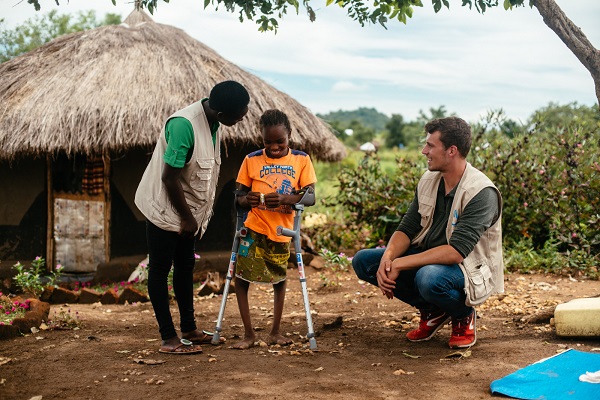 Tabita, a beneficiary of the tele-rehabilitation project, and her physiotherapist in Uganda;
Credit: © Quinn Neely / HI
Tabita, a beneficiary of the tele-rehabilitation project, and her physiotherapist in Uganda;
Credit: © Quinn Neely / HI
Handicap International, an NGO with a branch in Luxembourg, received yesterday two awards from the European Union for its innovative projects.
Tele-rehabilitation, production of prostheses using 3D printers, use of drones to locate mines: in its almost 40 years of existence, Handicap International has generated many innovations and launched initiatives that have revolutionised humanitarian aid. These efforts were praised on Thursday 24 September 2020 by the EU, which awarded the NGO two awards as part of the Horizon 2020 prize.
Since 1982, Handicap International has helped 6,000 amputees, victims of antipersonnel mines, by producing emergency prostheses out of bamboo, leather, wood and tyres, as well as wooden wheelchairs. Today, it is the first organization in the world to conduct physiotherapy sessions by video conference and to produce prostheses remotely for amputees, by scanning the stump and printing the prosthesis with a 3D printer - a feat rewarded yesterday by the EU.
Manuel Patrouillard, Managing Director of Handicap International, explained: “Our tele-rehabilitation project for all and the use of 3D technology illustrate our desire to improve the quality and impact of our interventions. Innovation should not be a matter for specialists, it should be accessible to as many people as possible. We have decided to continue along this path and to create a humanitarian fund for innovation from the Horizon Prize".
Another winning project was the use of drones for mine clearance. As early as 1992, in Cambodia, a country heavily contaminated by mines, Handicap International initiated demining for humanitarian purposes before contributing five years later to the ban on mines at the international level through the Ottawa Treaty. Today, in Chad, the NGO and its partner Mobility Robotics are using drones equipped with infrared cameras to locate mines buried in the ground allowing the mapping of vast contaminated areas in record time, where it took weeks with conventional means. to investigate the dangerousness of an area. These new methods will speed up demining operations and ultimately make land available to the populations.








